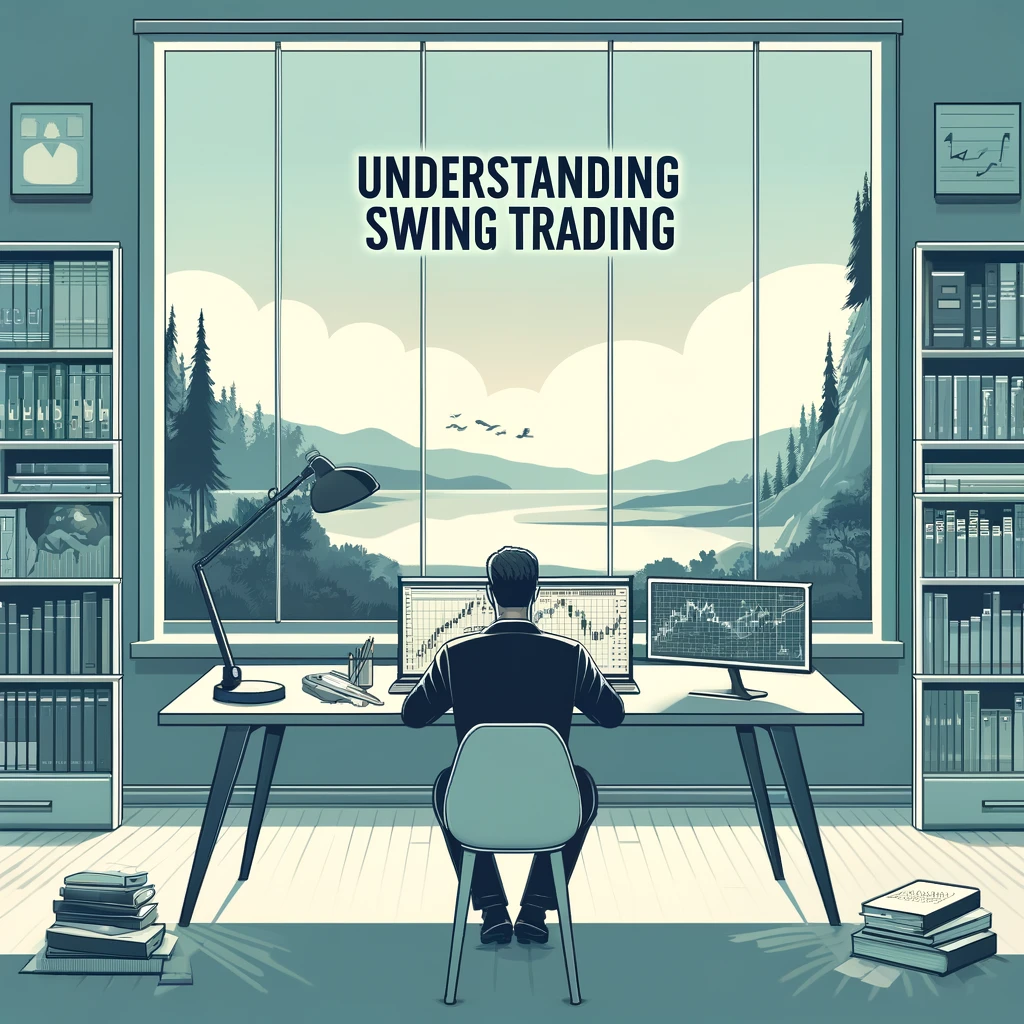The allure of the stock market is undeniable, with its promise of quick profits and the thrill of engaging with dynamic global economies.
However, the path to successful trading is not solely about the excitement or potential financial rewards; it’s fundamentally about finding a trading style that aligns with your lifestyle, personality, and investment goals.
Among the various approaches, day trading and swing trading stand out as two of the most popular, yet distinct, styles.
This comprehensive guide, titled “Day Trading vs. Swing Trading: Which Style Suits You?”, aims to delve into the nuances of both day trading and swing trading, helping you understand their mechanisms, compare their benefits and risks, and ultimately determine which might be the most suitable for your trading aspirations.
Understanding Day Trading

Definition of Day Trading
Day trading involves buying and selling securities within the same trading day.
Traders capitalize on small price movements in highly liquid stocks or currencies, aiming to enter and exit positions within minutes or hours to secure quick profits.
Key Characteristics of Day Trading
- Time-Sensitive: Positions are held for a very short duration, typically just a few hours, and never overnight.
- High Frequency: Many trades may be executed in a single day.
- Technology-Dependent: Requires real-time data, multiple screens, and fast execution platforms.
Typical Assets Traded by Day Traders
Day traders typically focus on stocks, forex, and futures, choosing assets that are volatile and liquid enough to offer multiple trading opportunities throughout the day.
Tools and Technologies Commonly Used
Successful day trading demands cutting-edge technology, including:
- Direct Access Trading (DAT) Systems: For immediate order execution.
- Charting Software: For real-time analysis of price action.
- News Feeds: To stay informed about market-moving events as they happen.
Examples of Day Trading Strategies
- Scalping: Making dozens or hundreds of trades per day to “scalp” a small profit from each.
- Momentum Trading: Identifying stocks moving significantly in one direction on high volume and riding the momentum to a quick profit.
Understanding Swing Trading

Definition of Swing Trading
Swing trading involves holding positions for several days to weeks to capitalize on expected upward or downward market shifts.
This style is particularly popular among those who cannot monitor their trades constantly.
Key Characteristics of Swing Trading
- Duration: Trades typically last from a few days to a few weeks.
- Less Frequent Trading: Compared to day trading, swing traders make fewer trades, focusing on larger, more predictable price movements.
- Research-Based: Utilizes a mix of technical and fundamental analysis to make decisions.
Typical Assets Traded by Swing Traders
Swing traders often deal with the same types of assets as day traders but may also include options and bonds to diversify their strategies.
Tools and Technologies Commonly Used
- Technical Analysis Software: For spotting trends over days or weeks.
- Risk Management Tools: Essential for managing trades over longer periods when the market could shift unpredictably.
Examples of Swing Trading Strategies
- Trend Trading: Identifying the direction of the market trend and trading in alignment with it.
- Counter-Trend Trading: Taking positions against the prevailing trend in anticipation of a reversal.
Comparative Analysis: Day Trading vs. Swing Trading

When choosing between day trading and swing trading, several key factors should be considered to determine which style best matches your personal circumstances and preferences.
1. Time Commitment Required for Each Style
- Day Trading: Requires a full-time commitment, as traders need to be present and attentive to market fluctuations throughout the trading day.
- Swing Trading: More suitable for those with other commitments, allowing for a more flexible schedule as it doesn’t require constant market monitoring.
2. Capital Requirements
- Day Trading: Often requires a larger capital base due to the high volume of trades and the necessity to leverage positions to make substantial profits from small price changes.
- Swing Trading: Can be started with smaller capital, as the gains are expected from significant price movements over longer periods, reducing the need for frequent high-volume trading.
3. Potential Profits and Risks
- Day Trading: Offers the potential for quick profits but comes with high risk, including the possibility of substantial losses, especially if leveraging positions.
- Swing Trading: While potentially slower to realize profits, the risks are often lower as positions are held over a period that allows for market correction and less reliance on leverage.
4. Psychological/Emotional Demands
- Day Trading: Highly stressful due to its fast-paced nature, requiring quick decision-making and constant vigilance.
- Swing Trading: Generally less stressful as it allows more time for decision-making and doesn’t demand constant market attention.
5. Skill Sets and Expertise Required
- Day Trading: Demands a deep understanding of market fundamentals, technical analysis, and a high level of trading expertise to manage rapid fluctuations.
- Swing Trading: Requires a good grasp of technical analysis and market trends but is generally more forgiving for those still developing their trading strategies.
Pros and Cons of Day Trading

Advantages
- Quick returns: Profits are realized daily.
- No overnight risk: Positions are not held overnight, avoiding the risk of significant adverse movements when the market is closed.
Disadvantages
- High transaction costs: Frequent trading increases costs, which can eat into profits.
- High stress: The need for constant monitoring and quick reactions can be mentally and physically exhausting.
Profile of a Typical Successful Day Trader
- Thrives under pressure and can make quick decisions.
- Has the financial acuity to understand complex market indicators quickly.
Pros and Cons of Swing Trading

Advantages
- Lower stress: More extended holding periods provide more time for decisions, reducing the pressure seen in day trading.
- Fewer transaction costs: Trading less frequently results in lower total transaction costs.
Disadvantages
- Overnight risk: Holding positions for multiple days exposes trades to overnight market changes.
- Slower capital turnover: Money is tied up for longer periods in trades, potentially reducing opportunities for other investments.
Profile of a Typical Successful Swing Trader
- Patient and disciplined, able to wait for the optimal moment to enter or exit a trade.
- Good at comprehensive market analysis to forecast potential movements over days or weeks.
Self-assessment Guide for Prospective Traders

To determine whether day trading or swing trading is the right approach for you, consider the following key aspects:
-
Risk Tolerance
- Day Trading: Suitable for those who can handle high-risk and rapid changes.
- Swing Trading: Better for those with a moderate risk tolerance, preferring slower and more calculated approaches.
-
Personality and Stress Tolerance
- Day Trading: This style is best suited for individuals who thrive in high-pressure environments and can make quick, decisive actions. It requires constant vigilance and the ability to remain focused under stress.
- Swing Trading: This style is more appropriate for those who prefer a more calculated approach, with the patience to wait for strategic opportunities. It’s ideal for individuals who handle stress better when they have more time to think through their decisions.
-
Financial Goals and Expectations
- Day Trading: If your goal is to generate quick returns and you have the capital to support potentially high transaction costs and losses, day trading might be suitable. It’s a good fit if you’re looking for aggressive growth and can afford the time and financial commitment.
- Swing Trading: If you prefer seeing your investments grow over a more extended period and are looking for relatively steady, albeit potentially slower, returns, swing trading might be the right choice. It’s suited for those who want to balance trading with other life commitments.
-
Time Availability
- Day Trading: Requires a substantial commitment of time during market hours. If you can dedicate a full workday to monitoring and reacting to the market, day trading can be a viable option.
- Swing Trading: Requires less time during the day, making it suitable for individuals with other jobs or responsibilities. If you can spend a few hours each week researching and managing trades, swing trading could be more appropriate.
-
Learning Curve and Market Knowledge
- Day Trading: There’s a steep learning curve. Effective day traders need to have a good understanding of the markets, including technical analysis and the ability to quickly interpret market news.
- Swing Trading: While still requiring market knowledge, the learning curve might be more gradual compared to day trading. Swing traders often rely more on overarching market trends and fundamental analysis, giving them more time to make decisions based on thorough research.
By assessing these aspects in relation to your own preferences and circumstances, you can better decide which trading style aligns with your personal attributes and financial objectives.
This self-assessment is crucial in setting yourself up for success in the trading world.
Real-life Case Studies

1. Case Study of a Successful Day Trader: Ravi
Background:
Ravi is a full-time day trader based in Mumbai, India.
With a background in software engineering, Ravi transitioned to day trading after discovering his passion for the financial markets.
He focuses primarily on trading equities and derivatives on the National Stock Exchange (NSE).
Trading Strategy:
Ravi uses a combination of technical analysis and market sentiment to make his trading decisions.
He employs strategies like scalping and intraday momentum trading.
Ravi begins his day early, analyzing pre-market data and news to gauge market sentiment.
He frequently uses tools such as moving averages, RSI (Relative Strength Index), and MACD (Moving Average Convergence Divergence) to identify potential entry and exit points.
Typical Day:
A typical trading day for Ravi starts at 8:00 AM with a review of financial news, market trends, and potential stock movements.
He trades actively between 9:15 AM when the market opens, and 3:30 PM when it closes, ensuring he does not hold any positions overnight.
Ravi makes multiple trades throughout the day, each lasting from a few minutes to a couple of hours.
Challenges and Rewards:
Ravi faces high stress due to the fast-paced nature of his trading style and the need to make quick decisions.
However, the potential for substantial profits within a single trading day is a significant reward.
Ravi emphasizes the importance of discipline, continual learning, and strict adherence to a trading plan as key factors in his success.
2. Case Study of a Successful Swing Trader: Anjali
Background:
Anjali is a part-time swing trader living in Bangalore, who balances trading with her career as a consultant.
She has been trading stocks and ETFs on the Bombay Stock Exchange (BSE) for over five years.
Trading Strategy:
Anjali’s approach to swing trading involves both technical and fundamental analysis.
She looks for stocks with strong fundamentals that are experiencing short-term price movements.
Anjali uses tools like Fibonacci retracement, candlestick patterns, and volume analysis to determine her trades.
Typical Week:
Anjali spends her weekends preparing for the week ahead by researching and setting up potential trades.
She monitors her positions in the evenings after work, making adjustments as necessary based on market movements.
Her trades typically last from several days to a few weeks.
Challenges and Rewards:
The main challenge Anjali faces is balancing her trading activities with her full-time job and personal life.
However, swing trading allows her the flexibility to maintain this balance without needing to monitor the market constantly.
The rewards for Anjali include building a substantial investment portfolio over time, with less stress and lower transaction costs compared to day trading.
3. Conclusion:
Both Ravi and Anjali have found success in the stock market through different trading styles that suit their individual lifestyles and goals.
Ravi enjoys the fast-paced excitement and immediate rewards of day trading, while Anjali appreciates the less intense and more flexible nature of swing trading.
Their stories highlight the importance of choosing a trading style that aligns with one’s personal circumstances, risk tolerance, and financial objectives.
Market Conditions and Their Impact on Trading Styles
Day Trading:
- High Volatility: Day traders thrive in highly volatile markets as they provide numerous opportunities for quick profits. For example, during market releases of significant economic news, day traders can capitalize on quick price movements.
- Low Volatility: In less volatile markets, day traders might struggle to find profitable opportunities and may need to adjust their strategies or reduce the number of trades.
Swing Trading:
- Stable Markets: Swing traders perform well in markets that show clear trends or patterns over days or weeks. Stability allows them to plan and execute trades that capitalize on these longer-term movements.
- Turbulent Markets: During market turbulence, swing traders must be adept at risk management, possibly relying more on technical indicators and diversification to mitigate risks associated with large, unpredictable price swings.
By understanding these dynamics, traders can better select the trading style that suits their financial goals, risk tolerance, and the current market environment.
Tools and Resources for Getting Started in Day Trading and Swing Trading

For Day Traders:
-
Brokerage Platforms:
- Zerodha Kite: A popular choice among Indian day traders for its user-friendly interface and low brokerage fees.
- Upstox Pro: Offers advanced charting tools and fast order execution, suitable for high-frequency trading.
-
Charting Software:
- TradingView: Widely used for its extensive range of indicators and real-time data across global markets.
- AmiBroker: Offers robust backtesting and automation capabilities, ideal for developing and testing day trading strategies.
-
Market Analysis Tools:
- Screener.in: A powerful tool for scanning stocks based on various criteria including price movements, financial metrics, and more.
- Moneycontrol Terminal: Provides real-time market data, news updates, and expert insights, crucial for making informed day trading decisions.
-
Educational Resources:
- Varsity by Zerodha: A comprehensive collection of tutorials on stock market fundamentals, technical analysis, and risk management.
- NSE’s Certification in Financial Markets (NCFM): Offers a range of courses tailored to securities markets, including modules specifically designed for day traders.
For Swing Traders:
-
Brokerage and Analysis Platforms:
- Sharekhan TradeTiger: Known for its comprehensive research reports and advanced trading tools.
- ICICI Direct: Provides detailed stock analysis and portfolio management tools, ideal for swing traders looking for long-term investment opportunities.
- Zerodha Kite: A popular choice among Indian day traders for its user-friendly interface and low brokerage fees.
-
Technical Analysis Software:
- TradingView: Widely used for its extensive range of indicators and real-time data across global markets.
- MetaStock: Offers real-time news, data, and analysis tools, with specific features tailored for swing traders.
- MotiveWave: A versatile platform that supports various forms of technical analysis including Elliott Wave, Fibonacci, Gann, and more.
-
Investment Research Tools:
- Trendlyne: Features sophisticated DVM (Demand Supply Zone Machine) and strength indicators to identify potential buying and selling opportunities.
- Investing.com: Offers a wealth of data on stocks, commodities, currencies, and more, along with advanced charting tools.
-
Community and Mentorship:
- Trading Q&A by Zerodha: An active online forum where traders can ask questions, share strategies, and learn from experienced traders.
- Traderji: A community forum that provides a platform for discussions about trading strategies, technical analysis, and the Indian stock market.
-
Workshops and Webinars:
- Elearnmarkets: Offers webinars and courses specifically designed for swing trading strategies and market analysis techniques.
By utilizing these tools and resources, aspiring traders can build a solid foundation of knowledge and skills, necessary for navigating the complexities of the stock market.
Whether you choose day trading or swing trading, aligning the right tools with your trading strategy is crucial for achieving long-term success.
Conclusion
Whether you lean towards the fast-paced world of day trading or the more measured approach of swing trading, the key to success lies in choosing a style that not only fits your financial goals but also matches your lifestyle and personality.
As you embark on this journey, remember that both trading styles require dedication, a willingness to learn continuously, and a strategic approach to managing risks and leveraging opportunities.











